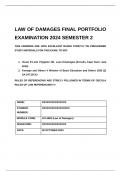Exam (elaborations)
October 2024 LPL4802 Law of Damages FULL ANSWERS INCLUDING QUESTION 4 ON DRAFTING
THIS DOCUMENT CONTAINS EXCELLENT REFRENCED ANSWERS FOR FOR LAW OF DAMAGAES EXAMINATION FOR OCTOBER DUE ON 30 OCTOBER 2024. ALL RULES AND THE TWO PRESCRIBED MATERIALS BEING THE TEXT BOOK AND GIVEN COURT CASE USED.
[Show more]




